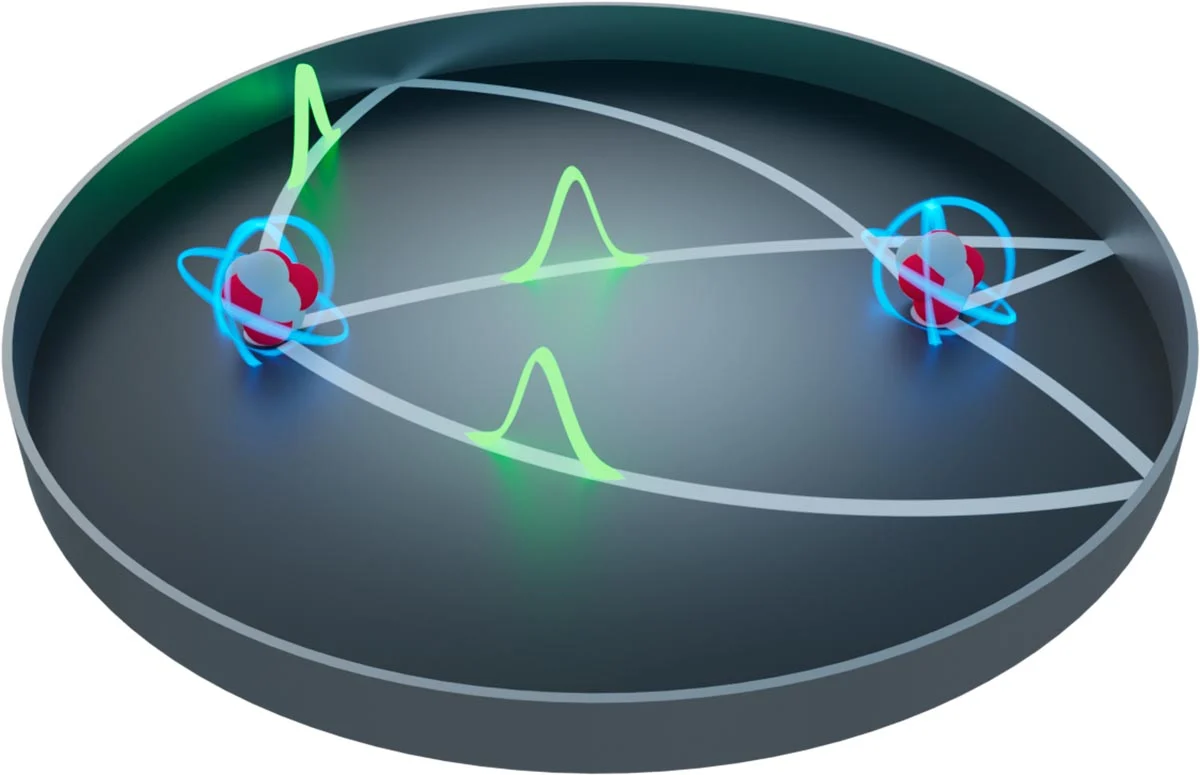Quantum computers can be smaller than atoms. And a new way to control biorobots.
"Emission of a single photon in the Maxwell fish-eye lens. Credit: Oliver Diekmann (TU Wien)" (ScitechDaily.com/Quantum Ping-Pong: The New Era of Atomic Photon Control)
Nanotechnology requires new types of computers. The nanomachines can control genetically engineered bacteria by turning DNA plasmid like a rudder.
But let's begin with quantum ping-pong. The DNA plasmids also can act as chemical qubits.
"Maxwell fish-eye lens with two atoms. A photon (green) is traveling between the two atoms along the curved light rays (white). Credit: Oliver Diekmann (TU Wien)" (ScitechDaily.com/Quantum Ping-Pong: The New Era of Atomic Photon Control)
Quantum ping-pong is the new atomic way to control light.
The ability to control light or photon flow at the single-atom- or subatomic level brings new ways to make quantum computers. Theoretically, quantum computers can be proton- or neutron-sized. The system transports information through the electron shells to quarks. And then the quantum system puts quarks into the superposition and makes quantum entanglement between them. There is also the possibility of making quantum computers using superpositioned and entangled electrons on the orbitals around the atom's core.
That thing allows us to make a new type of effective, atom-size quantum computer with two or three parts. And that thing turns those atom-size quantum computers into the "iron-based AI". The electrons and quarks inside protons and neutrons form three different entirety. If the system does not use quarks as the superposition, it can create superposition and entanglement between protons and neutrons as entireties.
That kind of atom-size quantum computers can revolutionize nanotechnology. If those miniature quantum computers are connected with nano-size microchips that thing allows us to make independently operating nanomachines. The atomic-size components allow the system to drive complicated code. And then there could be miniature thermos bottles, where those qubits exist.
The chemical qubits and biorobots.
It's possible to create a ring-shaped protein. And then on that protein is the small magnesite bites. Then the system drives data to those magnesite bites. And after that, the computer transports this enzyme to the gate. And if there are eight magnesite contact layers the system can drive data that is cut in eight pieces into the eight wires. And each of those wires is one state of qubit.
Plasmid wheel as a qubit.
This kind of thing can act as a chemical qubit. If there are bacteria that can create electric impulses the synthetic DNA or RNA can make these bacteria make the electric impulses, which allows them to send data to the non-organic binary computer. There is the possibility that the nano-size computer and DNA factory make the DNA encoded the data, and then the system turns that DNA into a plasmid wheel.
Then it cuts that plasmid into four (or more bites) and transports them into the four bacteria. Then those bacteria send information into the lines, and each of those (in this case) four lines is one state of the qubit. These kinds of systems can used to control biorobots.
Biorobots and nanotechnology. Nanomachine can turn DNA plasmid like a small rudder.
Biorobots are genetically manipulated bacteria. The DNA plasmid controls the bacteria's operations. The nanomachine that turns the DNA plasmid into the right position can drive bacteria in the direction, where controllers want. The DNA plasmid is like a rudder that the nanomachine turns.
Programming the bacteria can be based on the synthetic DNA or RNA bites. Those bites can connected to the protein or enzyme. The enzyme is like a long tape that normally catalyzes acid reactions. The reason why some enzymes make that thing is simple. There are acid molecules on the enzyme, and when it moves above the layer, that tape-looking molecule brings fresh acid molecules to the point.
There are other ways how enzymes can catalyze the acid reactions. But this kind of enzyme tape can also carry DNA bites to the right point of the bacteria. If those wheel-looking DNA molecules are transported near the nanomachine. That turns the DNA plasmid, the nanomachine can destroy the plasmid and then take the new one from the enzyme tape.
https://scitechdaily.com/quantum-ping-pong-the-new-era-of-atomic-photon-control/
https://learningmachines9.wordpress.com/2024/01/22/quantum-computers-can-be-smaller-than-atoms-and-a-new-way-to-control-biorobots/








No comments:
Post a Comment
Note: Only a member of this blog may post a comment.